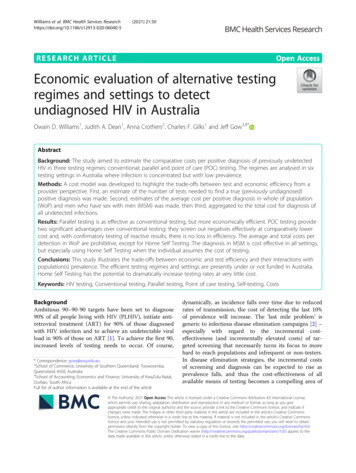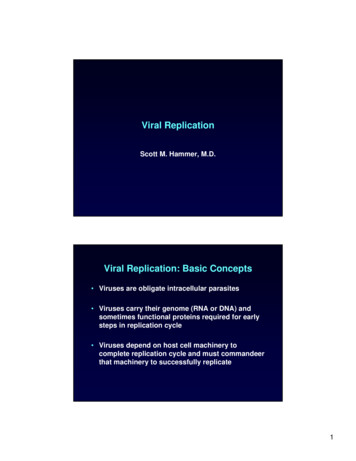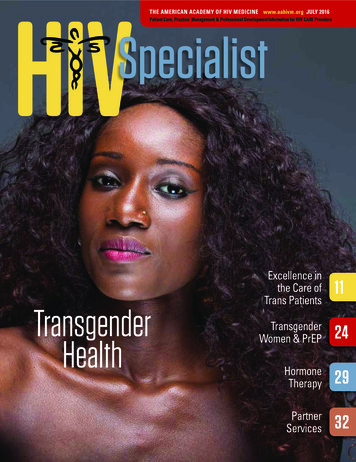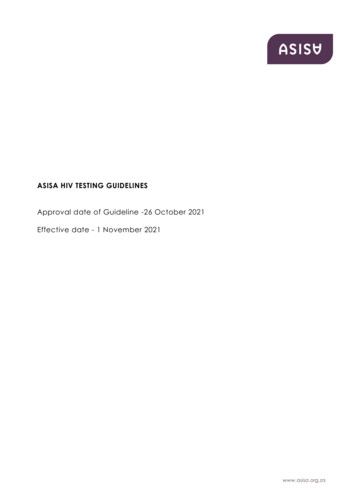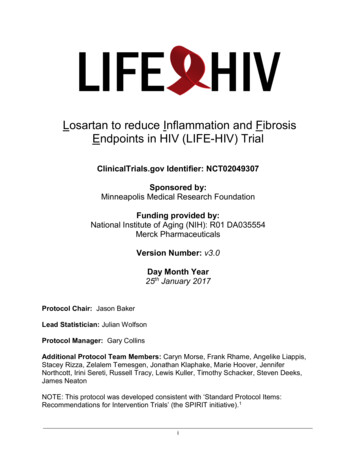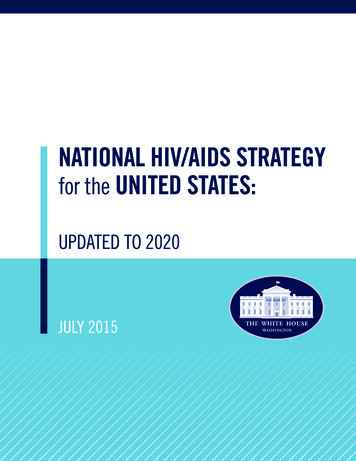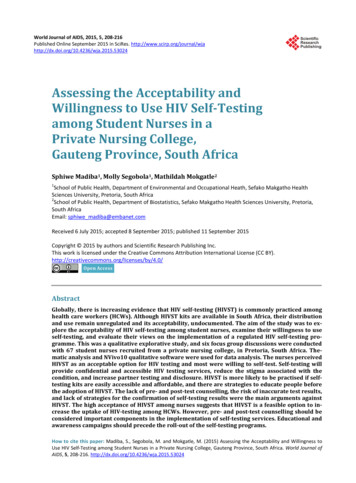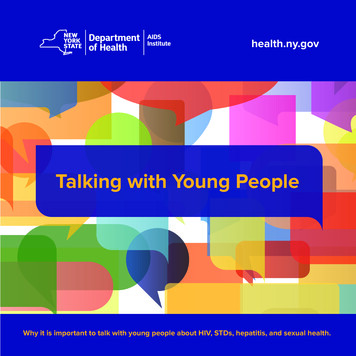
Transcription
ASSESSMENT / EVALUATIONEvaluation ofTransitioningan HIV Responseto Local Ownershipin Four CountriesMWAYABO JEAN CLAUDE KAZADI, MD, MPH, MBA
Since 1943, Catholic Relief Services has been privileged to serve the poor anddisadvantaged overseas. Without regard to race, creed, or nationality, CRSprovides emergency relief in the wake of natural and manmade disasters. Throughdevelopment projects in fields such as education, peace and justice, agriculture,microfinance, health, and HIV and AIDS, CRS works to uphold human dignityand promote better standards of living. CRS also works throughout the UnitedStates to expand the knowledge and action of Catholics and others interested inissues of international peace and justice. Our programs and resources respond to theU.S. bishops’ call to live in solidarity—as one human family—across borders, overoceans, and through differences in language, culture and economic condition.Catholic Relief Services228 W. Lexington StreetBaltimore, MD 21201-3413 USAAuthor: Mwayabo Jean Claude Kazadi, MD, MPH, MBAIndependent Consultants: Daphyne Williams and Rebecca J. Bennett 2015 Catholic Relief Services. All rights reserved. This material may not be reproduced, displayed, modifiedor distributed without the express prior written permission of the copyright holder. For permission,contact pqpublications@crs.org.This publication was funded by Catholic Relief Services and the views described herein are those of theauthors. The contents are solely the responsibility of CRS and do not necessarily represent the officialviews HRSA, CDC or the United States government.2
Table of ContentsEXECUTIVE SUMMARY. 1BACKGROUND. 3METHODOLOGY. 7COUNTRY PROFILE: UGANDA. 9COUNTRY PROFILE: KENYA.15COUNTRY PROFILE: TANZANIA.19COUNTRY PROFILE: SOUTH AFRICA.25KEY LESSONS LEARNED & RECOMMENDATIONS.29APPENDICESAPPENDIX A: INTERVIEWEES.33APPENDIX B: INTERVIEW GUIDES.353
List of TablesTABLE 1. AIDSRELIEF COUNTRIES, LOCAL PARTNERS, AND TRANSITION STATUS. 4TABLE 2: INTERVIEWS BY COUNTRY. 7List of FiguresFIGURE 1. UGANDA TWELVE-MONTH QUALITY INDICATORS.13FIGURE 2. UGANDA ART COVERAGE. 14FIGURE 3. KENYA TWELVE-MONTH QUALITY INDICATORS. 20FIGURE 4. KENYA ART COVERAGE. 20FIGURE 5. TANZANIA TWELVE-MONTH QUALITY INDICATORS.26FIGURE 6. TANZANIA ART COVERAGE.26FIGURE 7. SABC QUALITY INDICATORS.32FIGURE 8. SOUTH AFRICA ART COVERAGE.32FIGURE 9. ART COVERAGE: ALL COUNTRIES.33FIGURE 10. TWELVE-MONTH QUALITY INDICATORS: THREE COUNTRY AVERAGE.33FIGURE 11. TWELVE-MONTH QUALITY INDICATORS: LP DIFFERENCE.344
AcknowledgementsThe Evaluation of Transitioning an HIV Response to Local Ownership in Four Countrieswas made possible by the commitment of transitioned local partners in Uganda, Kenya,Tanzania and South Africa. Local partners and Catholic Relief Services staff havecontributed greatly to the understanding of how local partners are performing in theimplementation of antiretroviral therapy projects since the transition from AIDSRelieftwo years ago.The author wishes to thank all local partners and CRS staff for their review andcontribution to the evaluation. Special thanks to: John Donahue, Jennifer Overton,Anna Maria De Campos, Kioko Dema, Dr. Kwame Essah, Robert Makunu, Davor Dakovic,Elizabeth Pfizer, Carrie Miller, Leia Isanhart, Orhan Morina and Michael Johansson fortheir reviews and comments.5
AcronymsARTAntiretroviral therapyCAFChildren’s AIDS FundCDCCenters for Disease ControlCHAKChristian Health Association of KenyaCHAZChurches Health Association of ZambiaCMMBCatholic Medical Mission BoardCSSCChristian Social Services CommissionEIDEarly infant diagnosiseMTCTEnding Mother to Child Transmission (Uganda)FOAFunding opportunity announcementGOTGovernment of TanzaniaHMISHealth management information systemsHPACHealth Policy Advisory Committee (Uganda)HRSAHealth Resources and Services AdministrationIHVUniversity of Maryland School of Medicine Institute of Human VirologyINGOInternational nongovernmental organizationIPInternational partnerIYDSAInstitute for Youth Development—South AfricaJMSJoint Medical Stores (Uganda)KCCBKenya Conference of Catholic BishopsKECKenya Episcopal ConferenceLEADLocal Partners Excel in Comprehensive HIV and AIDS Service Delivery (Tanzania)LPLocal partnerLPTFLocal partner treatment facilityLTFULost to follow-upMAULMedical Access Uganda, Ltd.MEALMonitoring, Evaluation, Accountability and LearningMOHSWMinistry of Health and Social Welfare (Tanzania)PEPFARU.S. President’s Emergency Plan for AIDS ReliefPICTProvider-initiated counseling and testingPMTCTPrevention of mother-to-child transmissionSACBCSouth African Catholic Bishops ConferenceSCASite Capacity AssessmentUCMBUganda Catholic Medical BureauUECUganda Episcopal ConferenceUPMBUganda Protestant Medical BureauUSAIDU.S. Agency for International DevelopmentWHOWorld Health Organization6
CHAPTER HEADERExecutive SummaryBetween 2004 and 2013, the global AIDSRelief program supported rapid scale-upof HIV care and treatment services for poor and underserved people in ten countriesacross Africa, the Caribbean, and Latin America. AIDSRelief served more than 700,000clients, including more than 390,000 who enrolled in antiretroviral therapy (ART)through 276 facilities.AIDSRelief established basic packages of HIV care and treatment that exceededwhat many thought possible in resource-constrained environments. The programhelped broad cadres of health workers to identify and manage treatment failure orother adverse drug events; to diagnose, treat, and prevent opportunistic infections;and to provide patients with adherence counseling and support, empowering themto effectively manage their own treatment. The program also cultivated sustainablepatient access to quality services provided and managed directly by local partners.To capture and share knowledge gained through AIDSRelief’s transitions to localpartners, the Health and Social Services unit at Catholic Relief Services (CRS) hasdeveloped this learning document. Interviews with project staff, local partners, andfacility personnel involved with transition provide the foundation for an explorationof challenges, successes, and potential best practices identified in five AIDSReliefcountries.The experiences of transitioning grant management, clinical oversight, and strategicinformation management from a consortium made of international organizations towide-ranging local partners varied tremendously. In the four countries profiled in thisdocument, common themes appeared: cultivating a shared vision, bringing partners “tothe table” in a meaningful way, encouraging staff continuity, and balancing flexibilitywith prescription. Shared common understanding vision and commitment to transitionprocess, as well as improving local partner’s systems and building trust, confidenceamong stakeholders, facilitated the transition process toward local ownership.This analysis also made clear that sustainability is a process and there are degrees oforganizational maturity. For a successful transition, the receiver or local partner needsto have adequate organizational and technical capacity. Many local partners alreadyhave substantial capacity and most have the potential to strengthen their capacity.They are best positioned to address local problems because of their situationalknowledge and existing networks and relationships. However, even the most robustorganizations benefit from targeted outside expertise, which is often best provided byinternational partners (IPs): Large, well-resourced international institutions continue to have greater access tohighly specialized skills and knowledge than local partners. IPs are well positionedto provide technical assistance in these areas (e.g., U.S. government grant andfinancial management, state-of-the-art technology or clinical practices).1 / TITLE OF PUBLICATION
CHAPTER HEADER Competencies such as financial management and human resources typically takepriority in organizational development interventions. They are essential, yet afully realized organization must perform other functions (e.g., communications,documentation, advocacy, and qualitative research). IPs can provide resources andtechnical assistance in areas such as these. Successful transition to a truly local partner has emerged as a skill in itself anddirect experience is relatively rare. Transition requires dedicated resources; it mustbe scheduled, budgeted, staffed, and monitored, and it requires targeted capacitystrengthening. Donors and implementers must be willing to set up local partnersfor success by investing in deliberate, context-specific transition planning andimplementation. Experienced IPs and organizationally mature local organizationshave important roles to play in future development efforts.2 / TITLE OF PUBLICATION
BackgroundCLINICAL EXCELLENCE, OPTIMAL HEALTH OUTCOMESBetween 2004 and 2013, the global AIDSRelief program supported rapid scale-upof HIV care and treatment services for poor and underserved people in 10 countriesacross Africa, the Caribbean, and Latin America. AIDSRelief served more than 700,000clients, including more than 390,000 who enrolled in antiretroviral therapy (ART)through 276 facilities.AIDSRelief established basic packages of care and treatment that exceeded what manythought possible in resource-constrained environments. The program helped healthworkers identify and manage treatment failure or other adverse drug events, diagnose,treat, and prevent opportunistic infections such as tuberculosis or pneumonia, andprovide patients with adherence counseling and support, empowering them toeffectively manage their own treatment.AIDSRelief ConsortiumMembers & RolesCatholic ReliefServices (CRS): Primegrantee, technical leadfor grant managementand organizationaldevelopmentUniversity of MarylandSchool of MedicineInstitute of HumanA VISION OF SUSTAINABILITY & LOCAL OWNERSHIPVirology (IHV):The sustainability of patient access to quality HIV care and treatment was at theheart of AIDSRelief’s design. The program incorporated a vision for transitioning fullresponsibility to local partners without compromising the quality of care or programmanagement. Local partners were chosen for their national presence and interestin strengthening their capacity to provide and expand high-quality HIV care andtreatment services. They also were expected to become eligible for U.S. governmentfunding as part of the transition. By late 2014, local partners in eight of the 10 countriesreceived U.S. government funding for programming related to HIV care and treatment,six AIDSRelief country programs had completely transitioned responsibilities to thelocal partners, and transition was underway in two countries (see Table 1). Five of theseprograms are profiled in this report.clinical care andTHE STRUCTURE OF AIDSRELIEFTechnical lead fortreatmentFutures Group: Leadagency for strategicinformationIMA World Healthand Catholic MedicalMission Board (CMMB):Key sub-grantee, sitemanagementChildren’s AIDSFund (CAF): Keysub-grantee, sitemanagementThe U.S. President’s Emergency Plan for AIDS Relief (PEPFAR) funded the programthrough a grant from the Health Resources and Services Administration (HRSA) ofthe U.S. Department of Health and Human Services. Local Centers for Disease Control(CDC) offices oversaw day-to-day, in-country program implementation. Operatinglargely through faith-based rural facilities, AIDSRelief staff worked shoulder-toshoulder with local implementing partners and facility staff to ensure local capacitywas enhanced in all areas of program implementation.The five AIDSRelief consortium members had distinct and complementary roles; theirinvolvement in each country program was determined by their country presence andthe needs of the host-country local partners. Engaged consortium members providedtechnical support in areas of expertise to local partners and supported health facilities.3 / EVALUATION OF TRANSITIONING AN HIV RESPONSE TO LOCAL OWNERSHIP IN FOUR COUNTRIES
BACKGROUNDTABLE 1. AIDSRELIEF COUNTRIES, LOCAL PARTNERS, AND TRANSITION STATUS.COUNTRYLOCAL PARTNER(S)TRANSITION STATUSEthiopiaEthiopian Catholic SecretariatFollow-on project awarded to INGO.Ministry of HealthGuyanaDavis Memorial HospitalSt. Joseph Mercy HospitalHaitiKenya*NigeriaRwandaSouth Africa*St. Boniface FoundationChristian Health Associationof KenyaKenya Conference of CatholicBishopsChristian Health Associationof NigeriaCatholic Caritas Foundationof NigeriaTransitioned (2012) to local partners thatreceive U.S. government funding for HIVcare and treatment.First transition:Southern Africa Catholic BishopsConferenceFirst transition: Transitioned (2010)to local partners that receive U.S.government funding for HIV care andtreatment.International Youth Development—South AfricaChristian Social Services CommissionUganda Catholic Medical BureauUganda Protestant Medical BureauCAF UgandaZambiaTransitioned (2013) to local partners thatreceive U.S. government funding for HIVcare and treatment.Transitioned (2012) to local partners thatreceive U.S. government funding for HIVcare and treatment.Second transition:Department of HealthUganda*Follow-on project awarded to INGO.Ministry of HealthSt. Mary’s HospitalTanzania*Transitioned (2012) to local partners thatreceive U.S. government funding for HIVcare and treatment.Churches Health Associationof ZambiaChreso MinistriesSecond transition: Transition from localpartners to Department of Health isunderway. South Africa’s public healthsystem is taking full ownership of HIVcare and treatment.Transition underway through followon awards to AIDSRelief consortiummembers and local partners. Localpartners receive U.S. governmentfunding for HIV care and treatment.Transitioned (2012) to local partners thatreceive U.S. government funding for HIVcare and treatment.Transition underway; local partnersreceive U.S. government funding for HIVcare and treatment.*Profiled in this report4 / EVALUATION OF TRANSITIONING AN HIV RESPONSE TO LOCAL OWNERSHIP IN FOUR COUNTRIES
BACKGROUNDLEARNING FROM AIDSRELIEF EXPERIENCESWITH TRANSITIONTo capture and share knowledge gained through AIDSRelief’s transitions to localpartners, the Health and Social Services unit at CRS prepared this exploration ofchallenges, successes, and potential best practices in five AIDSRelief countries.Interviews with project staff, local partners, and facility personnel involved withtransition provide the foundation for this learning document.Most former AIDSRelief local partners have expanded the number of clients theyserve and services they provide since taking responsibility for their own programs,while maintaining service quality. In some cases partners identified a drop in quality,determined the cause or causes, and made needed adjustments. These monitoring andproblem-solving skills are quite literally lifesaving given the changing contexts in manydeveloping countries and the evolving HIV epidemic.Historically, local organizations have not had direct access to large amounts of fundingor international donors. Former AIDSRelief local partners developed the capacity toapply for, receive, manage, and effectively use substantially more money than in thepast. They complied with U.S. government financial requirements and opened doors toother funders.The achievements of former AIDSRelief local partners are often remarkable, particularlywhen one considers that widespread treatment for HIV was barely imaginable whenPEPFAR was launched in 2003, much less coordinated, quality treatment delivered andmanaged by local providers and organizations.5 / EVALUATION OF TRANSITIONING AN HIV RESPONSE TO LOCAL OWNERSHIP IN FOUR COUNTRIES
A public health clinic in the small town of Lufwanyama,Copperbelt, Zambia is one of many that receivedtechnical support from CRS staff.Photo by M. Jean Claude Kazadi.6 / EVALUATION OF TRANSITIONING AN HIV RESPONSE TO LOCAL OWNERSHIP IN FOUR COUNTRIES
MethodologyThis qualitative exploration consisted of a review of AIDSRelief program documentspre-transition, including transition plans, and 61 phone/Skype interviews (AppendixA) with CRS staff, local partners (LPs), current and former AIDSRelief staff, and localpartner treatment facility (LPTF) staff. (See Table 2.)For the Tanzanian documentation, the research team also interviewed governmenthealth ministry staff. In South Africa, the team conducted formative interviews withformer AIDSRelief staff that transitioned to LP management in 2008. Interviews withthe LP provided context and hindsight, especially as the LP is now leading the transitionto the government.A common interview guide (Appendix B), developed in consultation with various CRSformer AIDSRelief staff, was used in all interviews. The guide varied slightly in line witheach interviewee’s function in the organization and/or follow-on award. For example,researchers interviewed LPTFs regarding their experience as a subgrantee of a localorganization in comparison to their experience with AIDSRelief.Interviews were conducted by a consultant, and typically lasted 1.5 to 2 hours. Theybegan with an introduction of the purpose of the interviews and their future use, as itwas explained by the research team to the consultant. Most interviews were held withmultiple individuals to minimize scheduling challenges and limit access to the Internet,which would impact the quality of the Skype calls However in some cases, individualsspoke for the group. The interview team encouraged free discussion and reflectionwithout bias.Following the interviews, CRS reviewed, triangulated and analyzed data forcommonalities within the countries and across the countries. Each country profile wasshared with CRS headquarters staff and with the respective country to solicit additionalinformation, clarity, and comments and to ensure the intent of their responses wasaccurately conveyed. In some cases, the country disagreed with the observation of theLP and insisted on revisions.TABLE 2: INTERVIEWS BY COUNTRY.CRS/PROGRAM/INGO STAFFHeadquarters/CRS FieldLOCALPARTNERSLPTFGOVERNMENT16N/AN/AN/ASouth Africa2100Uganda0900Kenya1210Tanzania1405 GOT201615Total7 / EVALUATION OF TRANSITIONING AN HIV RESPONSE TO LOCAL OWNERSHIP IN FOUR COUNTRIES
METHODOLOGYEach CDC country office is semi-autonomous. Local decisions for specific strategiesto achieve a common goal are determined by the local office, which may account forthe variance in transition strategy. CDC Zambia indicated that each CDC country isresponsive to individual country context and that in Zambia, the intent and desire wasto get transition right from the very beginning. They also indicated that the programscale-up was new, as was the transition process.The documentation exercises consisted of key informant interviews that relied onmemory recall of events over two years ago and individual perceptions of relationshipsand performance. In all qualitative exercises relying on memory recall, there are severalopportunities for inaccurate recall, given the time between the transition and theinterview. As previously mentioned, interviews were triangulated, in part to account forthese potential biases.Skype was the primary method of interviews. Internet bandwidth restrictions didnot allow video calls and affected quality, which often resulted in a longer call. Theinterviewer remained flexible in rescheduling calls, monitoring the time and allowingfor the completion of questions offline, especially if the interviewee was to travel in thefield without Internet for some time.8 / EVALUATION OF TRANSITIONING AN HIV RESPONSE TO LOCAL OWNERSHIP IN FOUR COUNTRIES
Country Profile: UgandaAIDSRELIEF UGANDA ACHIEVEMENTSAIDSRelief Uganda supported 18 facilities providing comprehensive HIV care andtreatment services in Northern, Western, and Central Uganda. The program providedcare to a total of nearly 88,000 patients, including more than 35,000 on ART as ofFebruary 2012. Quality indicators were excellent: only 4.8 percent loss to follow-up(LTFU), 88.5 percent retention, and 7.5 percent mortality.All HIV-positive patients younger than 2 years old in Ugandan AIDSRelief-supportedfacilities were started on ART. AIDSRelief Uganda successfully lobbied the Ministry ofHealth to consider Option B for prevention of mother-to-child transmission (PMTCT)of HIV. In October 2011, the ministry invited AIDSRelief to launch a pilot study of thecountry’s first PMTCT Option B program. AIDSRelief shared details of this pilot (whichbegan with 12 facilities and 184 patients) to inform nationwide implementation plans.TRANSITION OVERVIEWEngaged consortium members: CRS, IHV, Futures, CAFLocal partners: Uganda Catholic Medical Bureau (UCMB), Uganda Protestant MedicalBureau (UPMB), CAF UgandaTransition year: 2012Transition period: Less than one year (August 2010 to February 2012)TWELVE-MONTH QUALITY INDICATORS, BY IMPLEMENTERImplementerYearLTFU (%)Retention (%)Mortality (%)AIDSRelief20124.888.57.5UPMB2014 1585.45.7UCMB2014 20845CAF Uganda20146.981.96.6Source: UCMB, UPMB, and CAF data as orally reported, May 2014.ART COVERAGE (CURRENT), BY IMPLEMENTERImplementerYearART patients CAF Uganda2014n/a*Source: UCMB and UPMB data as orally reported, May 2014.*CAF orally reported 26,000 patients ever on treatment as of May 2014; number of patients currently ontreatment was not available.9 / EVALUATION OF TRANSITIONING AN HIV RESPONSE TO LOCAL OWNERSHIP IN FOUR COUNTRIES
COUNTRY PROFILE: UGANDAAIDSRelief advocated for and trained staff to implement nurse refill programs, whichallow nurses with specialized training to provide routine care for stable patients, reducepatient wait times (facilitating clinic attendance and adherence), and lighten physicianworkloads (allowing time for more patients). By the end of 2011, 18 AIDSRelief sitesoffered nurse refill services for stable patients. The practice is now common in Uganda.TRANSITION PLANNINGTransition to local partners was part of the 2004 project designin Uganda, but it took time to cultivate a shared understandingof what “full transition” meant and how to achieve it. AIDSReliefworked closely with HRSA and CDC to develop a commonunderstanding. In late 2010, representatives from the AIDSReliefconsortium, local partners, and CDC Uganda formed the UgandaLeadership Forum on Transition based on the AIDSReliefZambia model. The forum was designed to provide directionand transparency in the transition process and to monitortransition plan implementation. Equal participation among forumparticipants was encouraged, for example, through relativelysimple policies such as rotating the organization responsible forhosting and chairing each meeting.AIDSRelief Uganda had a preliminary transition plan in placewhen HRSA, CDC, and AIDSRelief jointly assessed Ugandan localpartner capacity in 2010. (HRSA conducted similar assessmentsof local partners in each Track 1.0 country.) AIDSRelief and localpartners jointly developed an implementation plan and timelinefor capacity strengthening that responded to gaps identified bythe HRSA assessment. Interviewees from local partners reportedthat the transition plan began to feel “real” to them at this point.HRSA’s final assessment in August 2011 found that AIDSRelief andlocal partners were meeting their planned benchmarks.To further foster a smooth process, the transition plan alsoanticipated that local partners would sub-grant to AIDSReliefconsortium members to directly receive U.S. government funding.In the post-transition period, former consortium memberswould provide need-based technical support in clinical care andtreatment (University of Maryland School of Medicine Institute ofHuman Virology-IHV); strategic information (Futures); and finance,compliance, and site management (CRS and CAF).AIDSRELIEF UGANDA TRANSITION PLANNINGMILESTONESAUGUST 2010 HRSA conducted first local partner assessment inUganda. AIDSRelief Uganda hired full-time health systemsstrengthening manager and transition coordinator.SEPTEMBER 2010: CRS organized proposaldevelopment training for local partners.NOVEMBER 2010 AIDSRelief established Leadership Forum onTransition. Forum ratified AIDSRelief Uganda transition plan.NOVEMBER 2010: Transition plan presented tofacility representatives, and introductory meetingsorganized between local partner and facilityrepresentatives.JANUARY 2011: A CRS-sponsored businessdevelopment specialist worked with local partnersto develop necessary documentation and plans foranticipated U.S. government bid.MARCH–APRIL 2011: CDC announced fundingopportunity and CRS dedicated substantialresources in support of local partners’ biddevelopment.AUGUST 2011: Final HRSA assessment findsAIDSRelief and local partners achieving transitionplan benchmarks.SEPTEMBER 2011: CDC awards AIDSRelief programcomponents to UCMB, UPMB, and MAUL.NEW CIRCUMSTANCES REQUIRE A CHANGE OF COURSEThe CDC released a U.S. government funding opportunity announcement (FOA) forlocal organizations to assume management of components of the AIDSRelief program.CRS used private funds to support local partners UCMB, UPMB, and Joint MedicalStores (JMS) to develop and submit proposals in response. After a competitive bidding10 / EVALUATION OF TRANSITIONING AN HIV RESPONSE TO LOCAL OWNERSHIP IN FOUR COUNTRIES
COUNTRY PROFILE: UGANDAprocess, CDC awarded the major AIDSRelief program components to local entities: sitemanagement to UCMB and UPMB and supply chain to Medical Access Uganda, Ltd.(MAUL). Components of the awards varied from what was anticipated in the AIDSRelieftransition plan: MAUL was a new supply chain partner for AIDSRelief-supported facilities. (JMS hadhandled supply chain for HIV-related medicines under AIDSRelief.) The FOAs did not include the four sites managed by CAF under AIDSRelief. (Inresponse to partner concerns about this omission, CDC later asked UPMB tosubcontract management of the four sites to CAF Uganda for about one year, andthen issued another FOA and award to fund CAF directly.) Under the new awards, partners were expected to maintain and expand servicecoverage with significantly less funding than AIDSRelief. Timing of funding was unclear; for about six months, both AIDSRelief and localpartners had funding to manage the same sites and services. The new awards did not include technical support from international partners.In response to these changes, HRSA assessment results, and the imminent closure ofAIDSRelief, representatives from CDC, HRSA, AIDSRelief, UCMB, and UPMB revisedthe existing transition plan. By prioritizing and revising planned activities, thesestakeholders developed a fast-track transition plan for the last six months of AIDSRelief.Key AIDSRelief activities included: Final-round health facility assessments jointly conducted by AIDSRelief, UCMB,UPMB, and CAF using the Site Capacity Assessment (SCA) tool developed underand used throughout AIDSRelief Completion of computer networking and roll-out of financial management systemsto all supported health facilities Identification of significant project assets and creation of a final disposition plan tobenefit supported facilities and local partners Managing the transition of project staff to local partners to preserve collectiveinstitutional knowledge.AIDSRelief started to transition programmatic responsibilities and reduce technicalsupport to the local partners in accordance with the fast-track plan. Monthly meetingsbetween CDC Uganda, AIDSRelief, and local partners replaced the Leadership Forum,and CDC Uganda put each partner in charge of implementing and reporting itsprogress against assigned benchmarks. AIDSRelief no longer played a coordinating orleadership role with regard to transition.Some interviewees representing local partners said they felt that, in hindsight, the fasttrack transition period was not optimally used and that transition happened too fast.AIDSRelief representatives also noted some frustration with the process, including the11 / EVALUATION OF TRANSITIONING AN HIV RESPONSE TO LOCAL OWNERSHIP IN FOUR COUNTRIES
COUNTRY PROFILE: UGANDAconsortium’s rapidly diminishing role after eight years of deep personal investment.However, as one i
St. Mary's Hospital Second transition: Department of Health First transition: Transitioned (2010) to local partners that receive U.S. government funding for HIV care and treatment. Second transition: Transition from local partners to Department of Health is underway. South Africa's public health system is taking full ownership of HIV

